Killing Joke the Man Who Laughs Continuity Error
Batman: The Killing Joke is a "prestige edition" one-shot written by Alan Moore and drawn by Brian Bolland, published by DC Comics in 1988. It has in its original form continuously been held in print since then. It has also been reprinted as part of the DC Universe: The Stories of Alan Moore-trade paperback.
In 2008 it was reprinted in a deluxe hardcover edition. This Deluxe Edition features new coloring by Brian Bolland, meant to illustrate his original intentions for the book, with more somber, realistic, and subdued colors than the intensely-colored original. The reprint also included the story An Innocent Guy, which had earlier been included in Batman Black and White series of comics.
Synopsis
"The Killing Joke"
The plot revolves around a largely psychological battle between Batman and his longtime foe the Joker, who has escaped from Arkham Asylum. Batman paid a visit to Arkham Asylum, and specifically to the Joker's cell. He then tells the Clown Prince of Crime that he's been thinking of their battles, more specifically how they're most likely going to end: One of them is most likely going to kill the other, whether it be Joker killing Batman, or Batman killing Joker, that most likely it may happen either sooner or later, and wonders if Joker himself is aware of that. However, he then realizes the man in the cell is not actually the Joker due to his chalk skin smearing off when he tried to grab him, and demands to know where he is. The Joker intends to drive Gotham City Police Commissioner James Gordon insane to prove that the most upstanding citizen is capable of going mad after having "one bad day". As part of his plan, the Joker managed to scam the owner of a run-down amusement park into giving him control, also poisoning him in the process when shaking hands on the deal, revealing that the park was actually Joker's since an hour beforehand thanks to his minions forcing his business partner to grant Joker ownership. Along the way, the Joker has flashbacks to his early life, gradually explaining his possible origin.
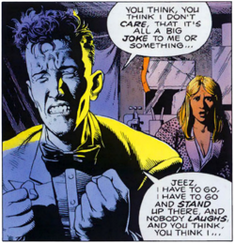
The pre Joker, with his pregnant wife.
The man who will become the Joker is an unnamed engineer who quit his job at a chemical company to become a stand-up comedian, only to fail miserably. Desperate to support his pregnant wife, Jeannie, he agrees to guide two criminals into the plant for a robbery. During the planning, the police inform him that his wife has died in a household accident involving an electric baby bottle heater. Grief-stricken, the engineer tries to withdraw from the plan, but the criminals strong-arm him into keeping his commitment to them.
At the plant, the criminals make him don a special mask to become the infamous Red Hood. Unknown to the engineer, this disguise is simply the criminals' scheme to implicate any accomplice as the mastermind to divert attention from themselves. Once inside, they almost immediately blunder into security personnel, and a violent shootout and a chase ensues. The criminals are gunned down and the engineer finds himself confronted by Batman, who is investigating the disturbance.
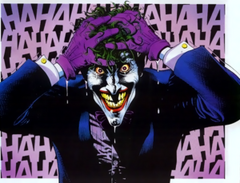
Bolland's iconic image of the Joker.
Panicked, the engineer deliberately jumps into the chemical plant's chemical waste catch-basin vat to escape Batman and is swept through a pipe leading to the outside. Once outside, he discovers, to his horror, that the chemicals have permanently bleached his skin chalk white, stained his lips ruby red and dyed his hair bright green. This turn of events, compounding the man's misfortunes of that one day, drives him completely insane, causing him to break out into hysterical laughter, and results in the birth of the Joker.
In the present day, the Joker kidnaps Gordon, shoots and paralyzes his daughter Barbara, and imprisons him in a run-down amusement park. His henchmen then strip Gordon naked and cage him in the park's freak show. He chains Gordon to one of the park's rides and cruelly forces him to view giant pictures of his wounded daughter in various states of undress. Once Gordon completes the maddening gauntlet, the Joker ridicules him as an example of "the average man", a naïve weakling doomed to insanity.
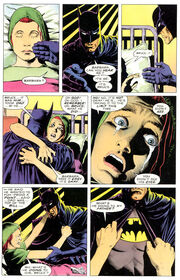
Barbara in the hospital
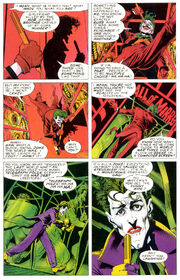
1988 version of the scene where Joker reveals his pessimistic views on the world.
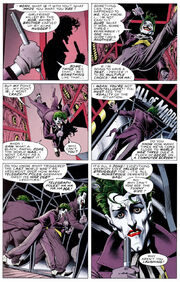
2008 version of the scene where Joker reveals his pessimistic views on the world.
Batman arrives to save Gordon, and the Joker retreats into the funhouse. Gordon's sanity is intact despite the ordeal and he insists that Batman capture the Joker "by the book" in order to "show him that our way works." Batman enters the funhouse and faces the Joker's traps while the Joker tries to persuade his old foe that the world is inherently insane and thus not worth fighting for, also claiming that Batman must have suffered from a bad day himself and gone insane as well, mostly because of his attire (with Joker being far more correct in his assumption than even he realized). He then commented that, while he doesn't remember exactly how his bad day went due to his memories changing every time, he knows he went crazy as a result, especially after knowing how the world was a black awful joke. He then ranted as to why Batman won't acknowledge he's gone crazy, especially when he's pretty sure the Caped Crusader was smart enough to see things from his eyes, pointing out how the Cold War frequently came close to escalating to World War III due to a flock of geese appearing on a computer screen, or how the second World War was allegedly caused by Germany entering an argument over the amount of telegraph poles they owed the Allies when undergoing reparations shortly after the first World War, and then denouncing everything everyone has strived to fight for as being a "monstrous, demented gag" before demanding to know why Batman not only doesn't see the funny side, but why he isn't even laughing at all. Eventually, Batman tracks down the Joker and, after explaining that the reason he isn't laughing at all, nor seeing it as a funny side is because he's heard the joke before, and it wasn't funny the first time around, subdues him. Batman then attempts to reach out to him to give up crime and put a stop to their years-long war; otherwise, the two will be eternally locked on a course that will one day result in a fight to the death between them. The Joker declines, however, ruefully saying "It's too late for that...far too late." He then tells Batman a joke that was started earlier in the comic:
- "See, there were these two guys in a lunatic asylum... And one night, one night they decide they don't like living in an asylum any more. They decide they're going to escape! So, like, they get up onto the roof, and there, just across this narrow gap, they see the rooftops of the town, stretching away in the moon light... stretching away to freedom. Now, the first guy, he jumps right across with no problem. But his friend, his friend did not dare make the leap. Y'see... Y'see, he's afraid of falling. So then, the first guy has an idea... He says 'Hey! I have my flashlight with me! I'll shine it across the gap between the buildings. You can walk along the beam and join me!' B-but the second guy just shakes his head. He suh-says... He says 'Wh-what do you think I am? Crazy? You'd turn it off when I was half way across!'"
- ―Joker's joke
The joke is funny enough to make the normally stone-faced Batman laugh. They continue to laugh as the police approach. Batman then grabs the Joker and the story ends, leaving it up to the reader to determine the Joker's fate.
Appearances
"The Killing Joke"
Individuals
- Batman
- Barbara Gordon
- James Gordon
- Alfred Pennyworth
- The Joker
- Jeannie
- Danny Weaver
- Two-Face (Cameo)
- The Penguin (Cameo)
- Red Hood (Flashback Only)
- The Joker's Carnival Freaks
Locations
- Gotham City
- Arkham Asylum
- Wayne Manor
- Batcave
- Ace Chemical Processing Plant (Flashback Only)
Items
- Joker Venom
Vehicles
- Batmobile
Influence in other media
Tim Burton claimed that The Killing Joke was a major influence on his film adaptation of Batman: "I was never a giant comic book fan, but I've always loved the image of Batman and The Joker. The reason I've never been a comic book fan - and I think it started when I was a child - is because I could never tell which box I was supposed to read. I don't know if it was dyslexia or whatever, but that's why I loved The Killing Joke, because for the first time I could tell which one to read. It's my favorite. It's the first comic I've ever loved. And the success of those graphic novels made our ideas more acceptable."
Despite Joker not appearing in Batman Returns due to dying in the first movie, there was at least one scene that had similarities to a scene from The Killing Joke. In particular, after Selena Kyle ended up using her "last life" to take out Max Shreck, The Penguin, having survived his descent into the waters of the penguin exhibit, attempts to use one of his umbrellas, with Batman witnessing it at the last second and looking concerned, only for Penguin to realize upon activating it that he accidentally picked the "cute" umbrella instead of his gun umbrella, which was similar to how the Joker upon being beaten by Batman attempted to use his gun to kill Batman only to realize upon firing it that he actually had used up all of its rounds (shown by his using the pop out flag saying "click, click, click").
The Joker's HP portrait in the SEGA version for Batman: Return of the Joker (titled Batman: Revenge of the Joker) was taken from Joker's "don't get even, get mad!" panel from the comic.
Although there was no direct adaptation of The Killing Joke in the DCAU, the Batman Animated Series episode "Make 'Em Laugh!" indirectly referred to Joker's alleged backstory of being a failed comedian in that comic, as Joker initially attempted to enter a Comedy contest unexpectedly only to be thrown out, and later proceeded to brainwash three of the judges to earn the title of the funniest man in Gotham. In addition, the episode Harley's Holiday had some thematic similarities to The Killing Joke, in particular the character Harley Quinn having a very bad day during her parole period, and also coming to a better understanding with Batman similar to the Joker. In fact, some of Harley and Batman's exchanges in the episode mirrored dialogue from the comic.
Director Christopher Nolan has mentioned that The Killing Joke served as an influence for the version of the Joker that appeared in The Dark Knight. Heath Ledger, who played the Joker, stated in an interview that he was given a copy of The Killing Joke as reference for the role. The most apparent influence of the graphic novel on the narrative itself would be the Joker's concept of his past as being "multiple choice" – in the film, he describes two conflicting scenarios to explain the origins of his scars to two different people - as well as his claim that a bad day could drive anyone mad, which he tries to prove through tormenting Gordon in the comic book, and Harvey Dent in the film. Both Jokers also explain their behavior and attitude as seeing what a twisted joke the world is, with the film stating in society "their morals, their code: it's a bad joke. Dropped at the first sign of trouble. They're only as good as the world allows them to be." In addition, the Joker, when relaying the second of his infamous scar stories to Rachel Dawes, says to her "Now I see the funny side. Now I'm always smiling!", which was similar to the line "So why can't you see the funny side? Why aren't you laughing?", also uttered by the Joker, in the aforementioned graphic novel. When revealing that he drove Harvey Dent insane as his "ace in the hole" for "the battle for Gotham's soul", Joker when explaining how it wasn't hard for him to accomplish says that madness was similar to gravity in that "all it takes is a little push", which was similar to Joker's line in the graphic novel of "all it takes is one bad day for the sanest man alive to be reduced to lunacy."
The infamous scene of Joker paralyzing Barbara Gordon was used in a flashback in Birds of Prey, with the only notable difference being that the Joker in this scene clearly knew the connection between Barbara Gordon and Batgirl when shooting her, while in the original comic and various other adaptations afterward, Joker was unaware of her being Batgirl as well.
The design of the Joker in the video game Mortal Kombat vs. DC Universe is based on The Killing Joke. In addition, one of his Fatalities, where he uses a bang flag gun before using a real gun on his opponent (censored in some versions) is named after the comic. The ending also has him sitting on a throne made of mannequins, alluding to a similar instance in the comic.
In the climax for Batman: Arkham Asylum, the Joker is seen sitting on a throne made of dismembered mannequins, alluding to The Killing Joke. In addition, Barbara Gordon's status as Oracle and being crippled by the Joker also references the comic. Joker also is about to recite a joke before interrupting himself and remembering he already told Batman that joke, alluding to the ending of The Killing Joke. His alias of "Jack White" was also referenced in the game.
The version of the Joker in The Batman paraphrased Joker's "one bad day" statement when explaining his origins, while also adding that another reason for his appearance was due to falling into a chemical bath.
During the interview tapes in Batman: Arkham City, Joker tells Hugo Strange his "Origin Story", which was based on The Killing Joke. Hugo, however, claims it to be fake, as he read up on 12 other "origin" stories that Joker had told. Joker also directly references Alan Moore's writing by stating that someone once told him to respond to his past with "multiple choices." In addition, the beginning of the trailer Joker's character trailer nearly quotes word for word what Batman told Joker, or rather, a double of him, in the beginning of the graphic novel, with the only difference being that, in a role reversal, it is Joker who tells Batman this.
A DLC of The Killing Joke was launched for Injustice: Gods Among Us which includes the tourist costume, the costume he uses in the final confrontation with Batman, and the Red Hood costume.
In the DC Animated Original film series movie Batman: Under the Red Hood, aside from references to the Joker's status as the original red hood, a flashback to Batman's first encounter with the Joker (or rather, the man who would become the Joker) at the ACE Chemical Plant has the man claiming that he was set up and that he wasn't a crook before tripping and falling into one of the chemical vats, alluding to the backstory given in The Killing Joke where he was strong-armed into participating in the heist. In addition, the second Red Hood, Jason Todd, indirectly alludes to Joker's crippling of Barbara Gordon from the comic nearing the end, with the Joker also briefly asking for a camera, alluding to his photographing Barbara Gordon to break her father's spirit.
In Batman: Arkham Origins, during Dr. Harleen Quinzel's patient interview with the Joker midway through the game, the flashbacks accompanying the Joker's story to Quinzel are based on his past from The Killing Joke (specifically, his status as a failed stand-up comedian and his brief heist as the Red Hood that led to his first encounter with Batman and his disfiguration). Just prior to the patient interview, Joker asked Quinzel "Tell me something, dear have *you* ever had a really bad day?", alluding to Joker's belief that it only takes one bad day to be driven insane in the comic. It also showed a flashback to a comedy club as well as him robbing the Ace Chemicals after being strongarmed by some criminals, alluding to the flashbacks from the same comic. In addition, his killing an amusement park owner to gain control of it via a handshake in the comic was also referenced in the same game, when he explains how he managed to get the equipment and set it up inside the Gotham Royal Hotel. The poem on the roof of the Gotham Royal Hotel also referenced The Killing Joke. Joker's voice actor for this game, Troy Baker, also recited his "madness being the emergency exit" monologue made by the Joker, in his Joker voice, from The Killing Joke at Comic-Con when he was announced to be the voice of the Joker for Arkham Origins. In addition, the achievement for beating Joker, "Maybe Sooner, Maybe Later", refers to what Batman said to Joker, or rather, a body double of the latter, when discussing the bleak future that their current feud will lead to, specifically one killing the other, during his visit to the Joker in the beginning of The Killing Joke.
In Batman: Arkham Knight, there was a fear toxin-induced hallucination/flashback referring to the events of Barbara Gordon's paralysis at the hands of The Joker from the comic, with Joker himself also casually alluding to his showing photographs to her dad, although neither the flashback nor his comments indicate that he stripped her naked for the photoshoots. Also like in the comic book, the flashback had Barbara Gordon opening the door thinking it was her friend Colleen. The DLC story "Batgirl: A Matter of Family" also indirectly alludes to his taking over of an amusement park and drawing out Commissioner Gordon for his own agenda from the comic, in this case, to force Batgirl and Robin into operating without Batman playing any role in it, also killing its owner beforehand. It is also implied that he did something similar to the comic after crippling her. His Jokermobile's ultimate attack during a hallucination near the ending, a missile salvo that wipes out everyone in the vicinity, is named after the comic.
The issue of Darkwing Duck "Toy With Me"'s cover, depicting Quackerjack using a camera with a worried Darkwing Duck on the camera lens, was taken directly from the cover for The Killing Joke.
Elements of Joker's character (specifically, his facial expression when asking why Batman not only doesn't see the funny side of everything being a joke, but why he's not laughing at all) have been reused in various other comic stories featuring him. In particular, in Whatever Happened to the Caped Crusader , the Joker has a similar depressed look when admitting that it wasn't funny even when it should have been when recounting how he killed Batman with enough Joker toxin to have even a regiment of elephants succumb to the effects and Batman still neither laughed nor even smiled upon expiring. Similarly, in Justice League of America, specifically the issue where Joker is temporarily rendered sane by Martian Manhunter, he shows the same expression when realizing that not only had he been insane for quite some time, but also the horrific actions he had conducted.
In the TV series Gotham, owing to Jerome Valeska's characterization being largely based on the Joker (and to a lesser extent, Jeremiah Valeska, his twin brother, actually becoming the Joker in that series), elements of The Killing Joke were used in some of his appearances. In particular, in the episode "Knock, Knock", Jerome's speech about how the people are "prisoners" to their sanity, and comparing it to a prison in their minds that obscures their being "tiny little cogs in a giant absurd machine" before telling them to be free like the Maniax, was similar to Joker's memories monologue in The Killing Joke. In addition, his character arc in Season 3, where he upon his revival abducted Bruce Wayne and tried to force him to go mad at the horrific carnival upon causing a blackout, was similar to how Joker tried to force Commissioner Gordon to go insane to prove that it only took one bad day to drive anyone insane. Lastly, after Jeremiah Valeska, Jerome's estranged twin brother, opened a gift that had been sent by Jerome post-humously and driven mad via the laughing gas, proceeded to make a similar pose to when Joker was driven insane in the graphic novel while giggling insanely. Likewise, Jeremiah Valeska's character arc was similar to what Joker described of how a bad day would drive the sanest man to lunacy in the graphic novel. Later after Jermiah kidnaps Bruce Wayne in a similar manner only difference is he isn't stripped naked.
The DC Showcase film Batman: Death in the Family, aside from plot points directly from Under the Red Hood, the events of The Killing Joke was referenced at least three times, all of which in the Jason Survives scenarios. The first instance is when Jason confronts the Joker and unmasks himself, causing Joker to flash back to his torture of Jason and cause him to say in shock and joy "One. Bad. Day.", referring to Joker's view in The Killing Joke that it merely took one bad day to drive someone insane. The second is shortly after this as Red Hood manages to kill Joker by shooting him in the head, where it shows Commissioner Gordon and Barbara hugging each other in silent relief over Joker's death, with the latter being in a wheelchair, referencing Joker's crippling of her. The third instance has the Joker, who was implied to have attempted to become sane out of guilt over Batman's death and using makeup to make himself appear more normal, relaying the same joke that he told Batman in the ending of that comic, causing Jason to recognize him immediately due to reading the files of Joker's crippling of Barbara, including transcripts of the joke, back when he was Robin and then promptly kill him by stabbing him in the eye after repeating what Joker said to him before leaving him to die to a bomb. The flashback to the files depict Barbara as still being clothed when Joker was photographing her after shooting her, a contrast to the comic where he undressed her beforehand. On a similar note, the flashbacks to Red Hood's unconscious murders of various crooks were depicted in black and white with some red utilized throughout, which was similar to the art style of the Deluxe version of The Killing Joke as well as the animated adaptation.
Trivia
- In The Killing Joke, the ending was ambiguous, leaving the fates of Batman and Joker to the reader. However, on August 2013, comic book writer Grant Morrison was a guest on Kevin Smith's podcast Fat Man on Batman this week, where he explained how he interpreted the book's ending:
"No one gets the end, because Batman kills The Joker. That's why it's called The Killing Joke. The Joker tells the 'Killing Joke' at the end, Batman reaches out and breaks his neck, and that's why the laughter stops and the light goes out, 'cause that was the last chance at crossing that bridge. And Alan Moore wrote the ultimate Batman/Joker story… he finished it." [1]
However, there are contradictions to Morrison's idea, some of which coming from the script.[2] [3] [4] - Neither Batman nor Joker are ever referred to by name in the comic (aside from a brief viewing of the wanted poster bearing Joker's visage). The initial French release, however, does have Joker being referred to by name once: When Batman discovers the impostor in Arkham Asylum, Batman shouts "Vous n'êtes pas le Joker!", which literally translates to "You're not the Joker!"
- The ending joke appears to be inspired by an older joke performed by Red Skelton on The Ed Sullivan Show on September 29, 1968.[5]
- In the 2011 Comic-Con, Mark Hamill said that if there would ever be an animated version of The Killing Joke, he would gladly voice the Joker again, encouraging fans to campaign for said adaptation,[6] [7] most notably in a tweet made on October 24, 2011.[8] Since then, a Facebook page titled "Petition to get Mark Hamill to play the Joker in animated Killing Joke" has been set up by his fans.[9] At the premiere of The Dark Knight Returns Part 2, producer Bruce Timm dropped a couple hints about DC animated projects, one of which is the possibly of doing a Killing Joke adaption.[10] At ComicCon 2015, Bruce Timm confirmed that one of the film lineups for 2016 includes an animated adaptation of The Killing Joke, with Mark Hamill crossing his fingers of being allowed to voice Joker when the casting call comes.
- Originally, it was intended that, in addition to Joker shooting Barbara Gordon through the spine and taking nude photos of her to drive her father insane, that Joker was to be explicitly depicted as raping Barbara Gordon. Artwork for the scene was even created, and the scene ended up cut, although rape was still implied in the final version. Gosh! Comics' Billy Hynes eventually tweeted the original page on December 1, 2013.[11] [12]
- A film adaptation of the Killing Joke was announced on July 21st 2015, with Kevin Conroy and Mark Hamill returning to voice Batman and the Joker, respectively.[13] In addition, the film was confirmed to premiere at San Diego Comic Con on July 21-24, 2016. Bruce Timm also mentioned the film will have a 15-minute prologue section original to it, explaining that there wasn't enough in the source material itself to make a full-fledged movie.[14] It also received an R rating, the first DC Universe Animated Original Movie to have done so.[15] The film received mixed reviews, with praise for Hamill and Conroy's performances and faithfulness to the story, but criticism primarily given towards the prologue and portrayal of Barbara Gordon.
Notes and references
- ↑ Grant Morrison: Batman kills Joker in The Killing Joke - Batman-News
- ↑ Did Batman Kill The Joker at the End of 'The Killing Joke'? - ScreenRant
- ↑ The Killing Joke Script Proves Batman Didn't Kill The Joker | Comicbook.com
- ↑ MTV Geek - Batman Didn't Kill The Joker In 'The Killing Joke,' Pretty Much 100% Confirms Alan Moore's Script
- ↑ "Red Skelton on The Ed Sullivan Show" on YouTube
- ↑ 1:30 mark of Interview with Mark Hamill at Comic-Con 2011
- ↑ SDCC 2011-BAC: Mark Hamill Interview
- ↑ HamillHimself on Twitter
- ↑ Petition to get Mark Hamill to play the Joker in animated Killing Joke
- ↑ Bruce W. Timm On A Possible KILLING JOKE Animated Film - Comic Book Movies
- ↑ https://twitter.com/BillyHynes/statuses/407262919760805889
- ↑ http://www.breitbart.com/Big-Hollywood/2013/12/08/Revealed-DC-Comic-Was-to-Have-Featured-Rape-and-Torture-of-Batgirl (archived version)
- ↑ http://collider.com/batman-the-killing-joke-mark-hamill-voicing-joker
- ↑ http://www.denofgeek.us/movies/batman/247618/batman-the-killing-joke-animated-movie-news-premiere-date-story-details
- ↑ http://www.ew.com/article/2016/04/14/batman-killing-joke-animated-rated-r
Source: https://batman.fandom.com/wiki/Batman:_The_Killing_Joke
0 Response to "Killing Joke the Man Who Laughs Continuity Error"
Post a Comment